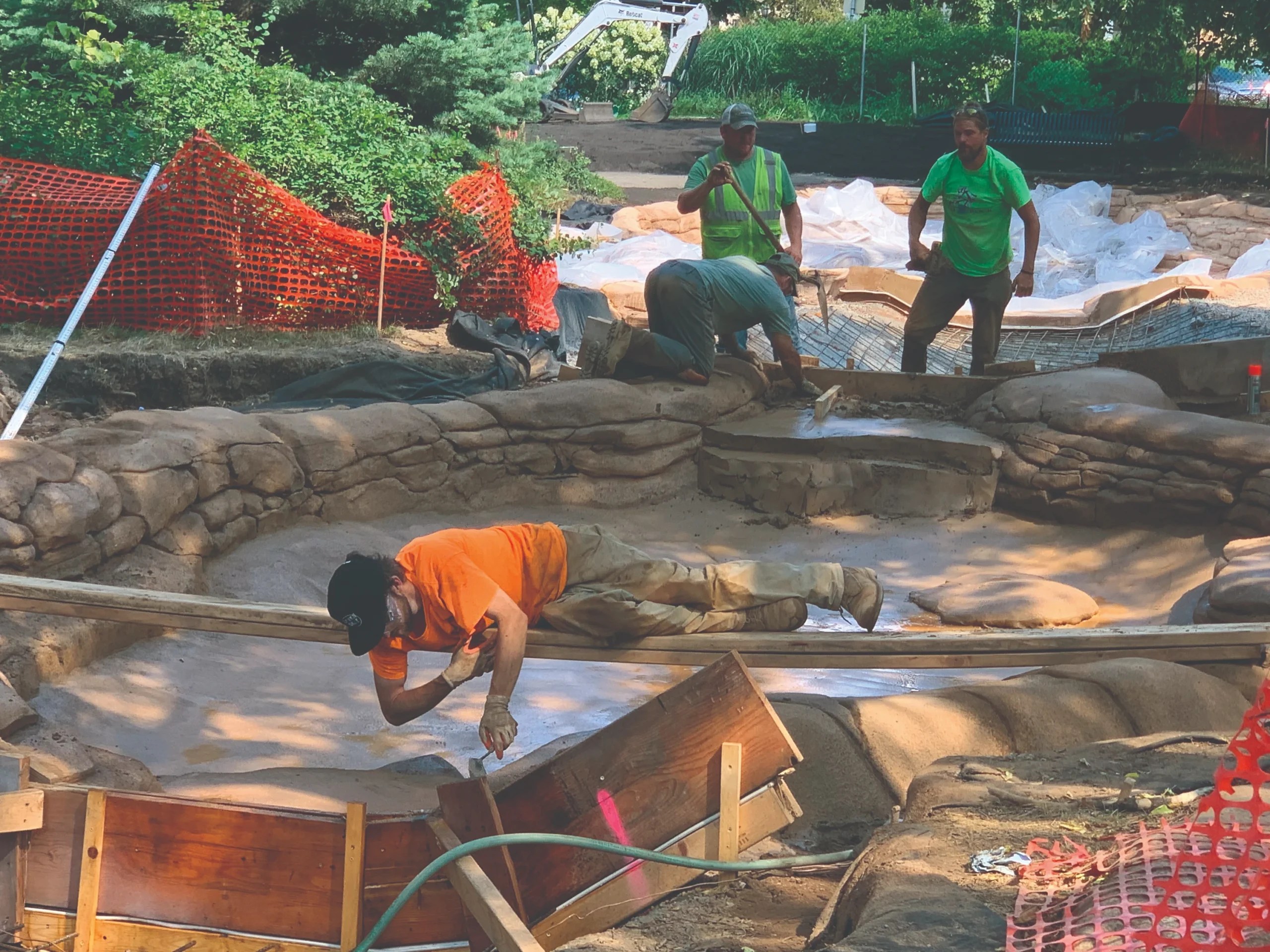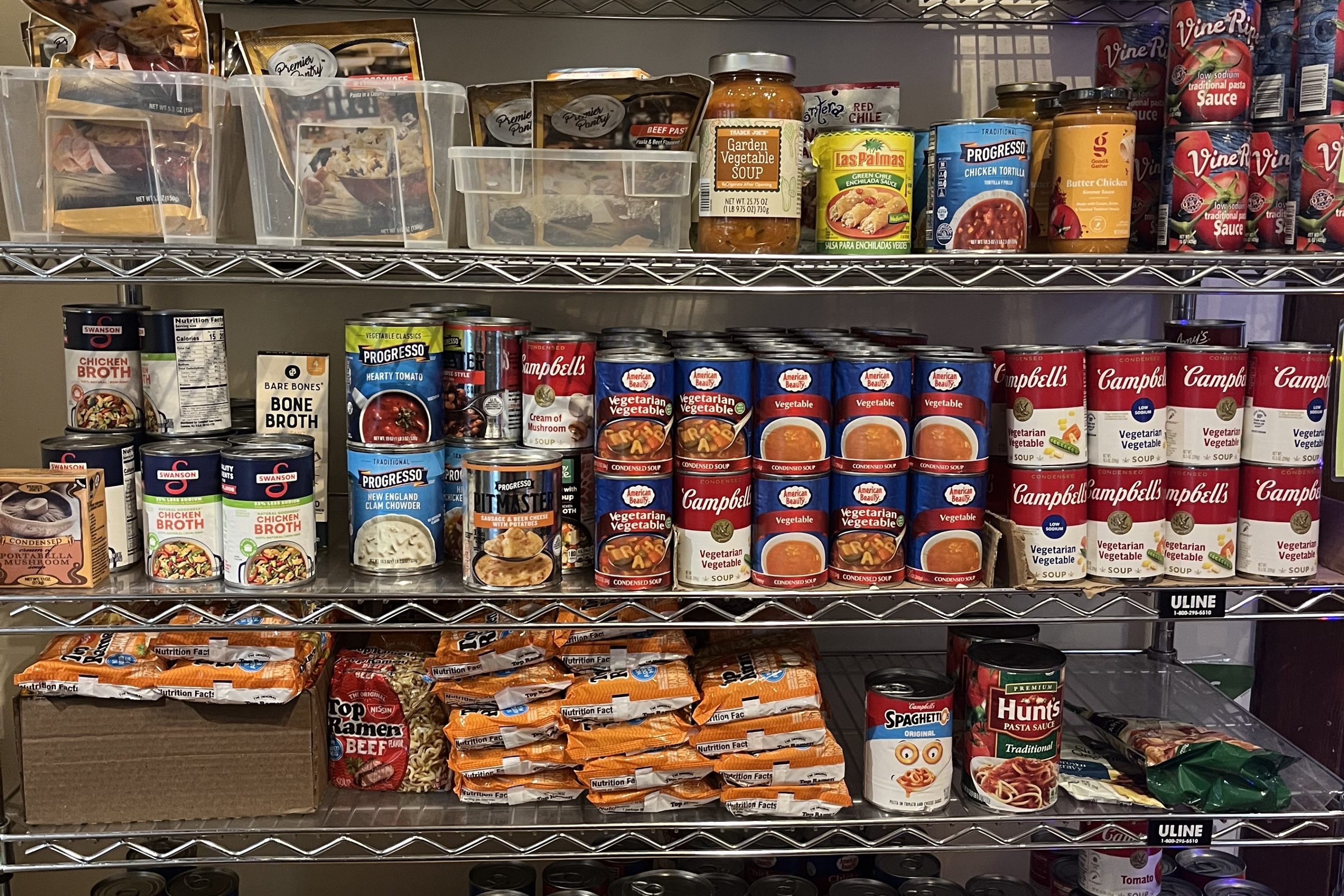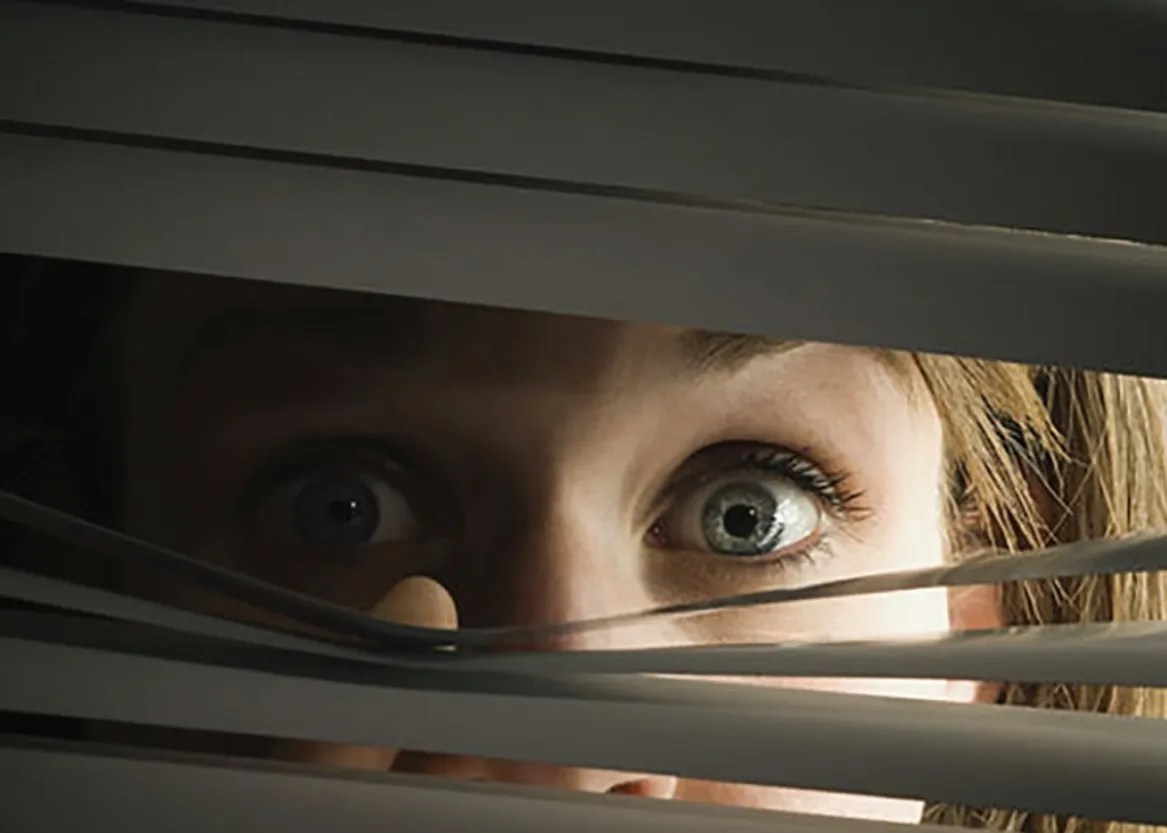In 2019, signs started appearing in yards throughout the Lowry Hill, Kenwood and East Isles neighborhoods — Save the Seven Pools.
Two years and a pandemic later, the neighborhoods celebrated the completion of the Seven Pools restoration on September 25 and 26, 2021. What seems a straightforward and streamlined project was full of headaches, problems and obstacles. However, once again, Thomas Lowry Park was saved thanks to the hard work of a dedicated group of volunteers as well as some good luck.
A Passive Park
In 1984, the small public park at the intersections of Mount Curve, Colfax Avenue and Douglas Avenue was renamed Thomas Lowry Park, honoring the Lowry Hill resident who gave generously to the Minneapolis park system. Although small, the park was highly trafficked. Its beautiful design by Phelps Wyman with the seven pools flowing down from the pergola was a popular site for leisure and celebrations.
Jeremy Nichols fondly reminisced, “When Evelyn and I decided on an outdoor wedding, the seven pools were a unique and lovely setting. Our wedding was on June 23, 1979. It rained all day. The sun came out a couple of minutes before 6 p.m., shining brightly on our wedding. There was a dozen or so people there for about a half hour. None had seen anything like this little park. We return to the pools every June 23 at 6 p.m. to commemorate our marriage."
Many people recall splashing and swimming in the fountains on a hot day, especially before air conditioning was common. And, of course, there is the confession of sneaking some beers up to the park as teens on a summer night. When a place has this special history and has been part of the community for years, it is a shock when things are abruptly upended. Such a change loomed in 2018 as the park was in a dire state.
The pools had mechanical components that required attention and repairs over the years. In the fall, the water had to be turned off and, in the spring, turned back on. This meant finding “the guy” as there seemed to be one guy at the park board who knew how to work the aging machinery.
The Facelift
In 1994 the park received a much-needed grant of $300,000 as part of the Neighborhood Revitalization Program, commonly referred to as NRP, to add additional brick paths, iron benches, fresh landscaping, an irrigation system and more lighting. Local landscape architect and neighbor Damon Farber led the design solutions that refreshed the park.
But by 2003 a budget crisis caused the park board to shut down the water in the seven pools. The neighbors rallied again and raised $8,500 to keep the water on for the season. In 2004 the installation of a re-circulating pump saved millions of gallons of water per season. Each year saw a few more repairs.
At this point, dedicated volunteers were ready to create an auxiliary charitable organization to focus on the ongoing needs of the park. In 2008 The Friends of Thomas Lowry Park was incorporated as a 501(c)(3) Minnesota nonprofit under the leadership of Barry Lazarus, Barbara Fogel and Sara Peterman.
Craig Wilson, who was serving on the Lowry Hill Neighborhood Association at the time, was able to partner with the Friends board to secure additional funding for irrigation, additional plantings and an urn that was later dedicated to Barbara Fogel for her decades of service to Thomas Lowry Park in 2015.
Over the years, the Friends board settled into a routine of maintenance — planting seasonal plantings and the occasional trees with all too frequent irrigation repairs — led by Suzanne Payne and a cast of volunteers, but every spring there was a perennial battle to get the fountain flowing.
The Tipping Point
When the Roman philosopher Seneca said, “luck is what happens when preparation meets opportunity," he could have been thinking of the restoration of Thomas Lowry Park, as a perfect storm of preparation, luck and opportunity transpired.
In June 2018 the water had still not been turned on in Thomas Lowry Park, and it appeared that the pump system could no longer be repaired. Fortunately, Elizabeth Shaffer and Craig Wilson both became board members of Friends of Thomas Lowry Park that summer and provided important knowledge, resources and vision.
At that time, Craig had recently been recruited by Sarah Janecek to rejoin the neighborhood board. Sarah, a well-known political pundit, loved her Lowry Hill neighborhood and believed that money should be used for the public good and that Craig could be a great partner in this endeavor.
Craig and Sarah were co-chairs of its Neighborhood Revitalization Committee, but sadly, Sarah died soon thereafter.
Craig was alerted by city staff and local representatives that the neighborhood organization had a large amount of unspent funds that needed to be used or lost. This serendipitous discovery provided an opportunity to fix the fountain for another 100 years.
When Craig approached the Friends board with the idea either to fix permanently or replace the fountain, the idea was initially met with skepticism — apart from Elizabeth Shaffer, who was open to, and advocated for, the possibility.
As a consultant to the park board, Craig knew to approach Michael Schroeder, the assistant superintendent of planning. Michael agreed that a study should be done to determine the best course of action, and Lowry Hill agreed to fund this first step.
Simultaneously, the park board entered into a planning process for 43 neighborhood parks in southwest Minneapolis bordered by 394 in the north, 35W in the east, 62 in the south and France Avenue in the west. Craig was appointed by area neighborhoods to represent them on the Park Board’s Community Advisory Committee, commonly referred to as a CAC. This role enabled Craig to advocate for Thomas Lowry Park.
When the CAC members visited different parks, Craig made sure that they toured Thomas Lowry Park so he could share the history and emphasize its distinctiveness as a passive park — without a recreation center, playground or sports facilities like many other neighborhood parks. The CAC readily grasped that it was worthwhile to preserve a neighborhood park that is focused on quiet activities and serves as a community gathering spot.
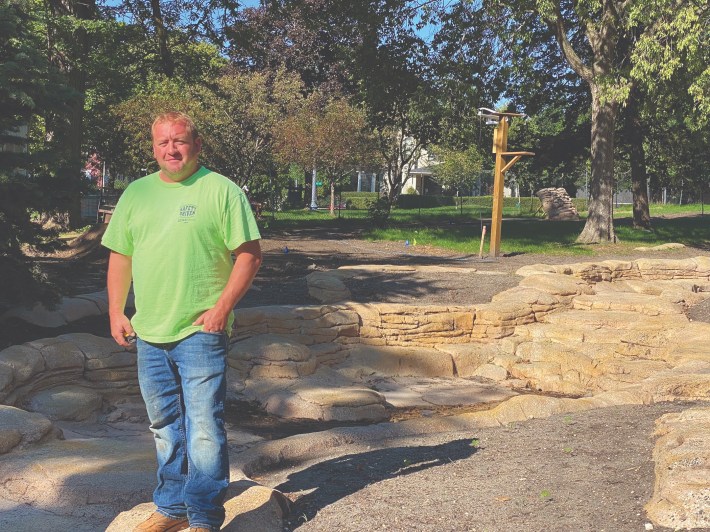
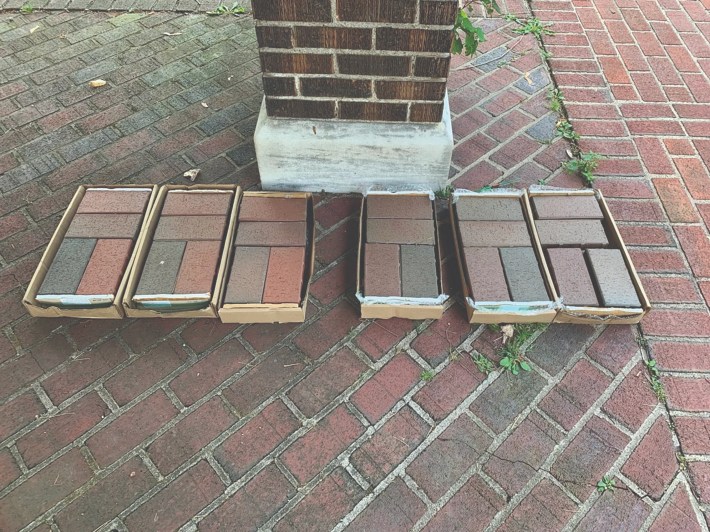
The Sandstorm
In October 2018, the park board consultants shared their plan for fixing the problems at Thomas Lowry Park. The consultants suggested a practical solution for removing the liability of the fountain and providing lowcost recreation. They did not focus on the history and importance of the original design when they proposed that the wading pools be filled in with sand and large boulders added for a “nature play” feature. It seemed that the treasured 100-year-old design of tranquil waterfalls would end.
As in 1922 when a hotel threatened this piece of land, the community was spurred to action. “Consultants to the park board did us a huge favor by presenting conceptual plans to fill in the fountain with sand. It mobilized community action and kicked our efforts into full throttle. It was perfect timing with its audacity. Even my fellow committee members from throughout the southwest were dumbfounded by its insensitivity to local desires and historic context,” explained Craig. He convinced the committee to reject the sandbox concept and support the historic Seven Pools fountain and traditional layout and passivity of the park.
By this time, Elizabeth Shaffer had become the president of Friends of Thomas Lowry Park, and the board — Barry Lazarus, Kathy Gaskins, Suzanne Payne, Paul Pender, Craig Wilson, Jeanne Scheiderer, David Piper, Tom Trondson, Mark Tierney, Shirley Cardozo, Kathleen Bottini and Kobi Conaway — were fully committed to the vision to save the pools.
The group offered the park board another possibility — what if three sources of funds were combined to reach the required amount? The Lowry Hill money, the park board’s money and a third source raised by the Friends board could get it done.
The park board accepted this proposal to preserve the passive historic park. There was no time to lose. Craig executed on the study, mobilizing Lowry Hill’s funding and aligning political support; Elizabeth Shaffer jumped into fundraising and building a campaign.
On November 16, 2018, Aune Fernandez Landscape Architects presented its report including three possible design options. FTLP liked the option that kept with the original park design. But it was also the costliest option. FTLP now had their financial goal and set out to reach it.
Neighborhood Solidarity
In order for the Lowry Hill Neighborhood Association to allocate the $300,000 of NRP money, a neighborhood-wide meeting was required to vote and approve. On February 5, 2019, Lowry Hill neighborhood residents filled Kenwood Community Center to hear, discuss and vote on the motion that “...a major plan modification in Neighborhood Revitalization Program monies reallocating up to $300K for use to replace the Seven Pools Fountain at Thomas Lowry Park.”
Craig employed the practical and emotional points into his speech. “For so many of our Lowry Hill residents in this area, they don’t have yards and Thomas Lowry Park is their only green space oasis. I think the soul of the park, and frankly our neighborhood, is the Seven Pools fountain. A future without it is simply sad.”
The neighborhood agreed and passed the motion nearly unanimously. With the initial funding secured, The Friends board embarked on an ambitious and highly successful campaign to raise funds while navigating the park board’s approval process, which was led by Elizabeth Shaffer.
All was going according to plan. And then, the pandemic brought the city to a halt.
The Luck of the Pandemic To hear of something going faster or without delay in 2020, the year of the pandemic, is highly unusual. However, that is just what happened with the restoration project of Thomas Lowry Park.
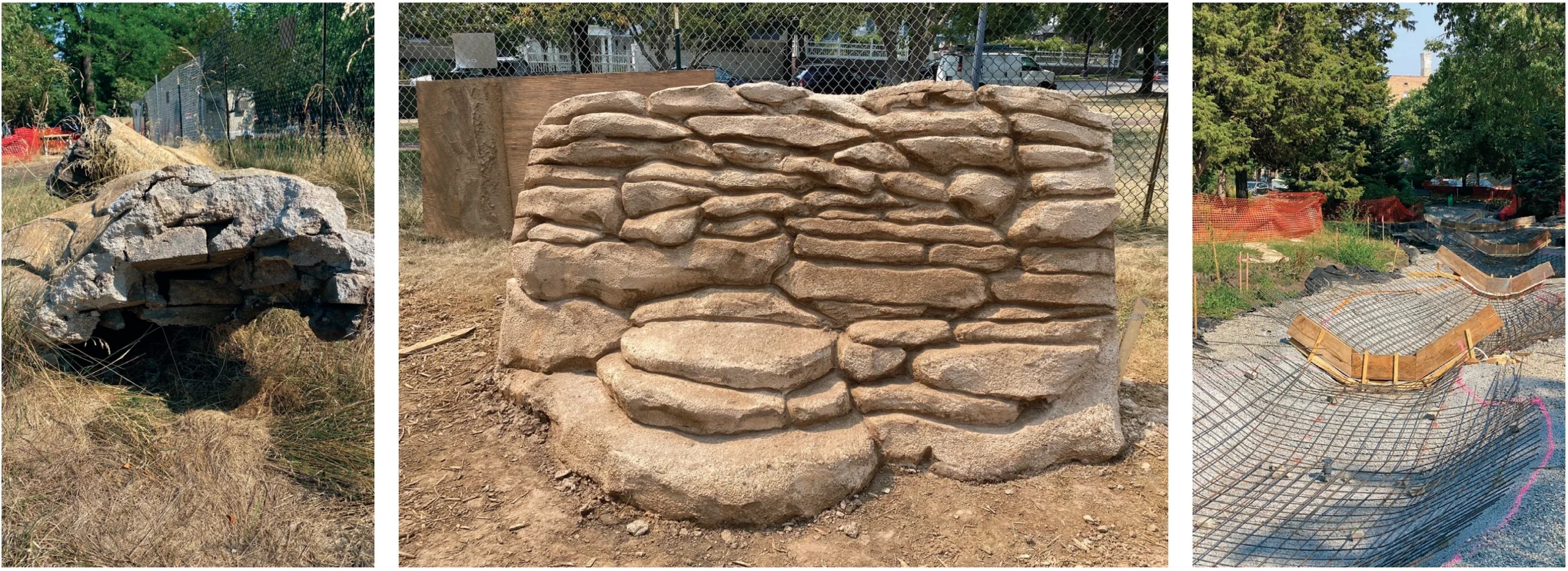
Fundraising received help as people who were working at home and unable to go to gyms were walking the neighborhoods, appreciating nature, and seeing the Save the Seven Pool signs. Donations started to come in.
Elizabeth Shaffer’s passion for the project and organization were critical during the pandemic. She kept everyone positive and motivated. All board members worked very hard to secure the necessary contributions and make wise decisions that impacted the project — an amazing combination of expertise, passion and camaraderie.
There was speculation that Elizabeth had a second home in the park as she seemed constantly to be there sharing the story and soliciting donations when she wasn’t at some other neighborhood event doing the same. Her energy was contagious, eventually leading her to seek office and represent the area as the District 4 Park Board Commissioner.
What motivated her? Commissioner Shaffer clarified, “for me, leadership is simply service to the people and needs that are around me. The Seven Pools are a half block from my home and were a community need that many of us wanted to give back to.”
By the end of the campaign, Friends of Thomas Lowry Park received donations from over 350 donors from 13 different states. Jean Stern Newman mailed her donation from Virginia and included a photo of her brother, mother and her self at Thomas Lowry Park in 1948.
Many people found creative ways to raise money. Twelve-yearold neighbor Hallie chose Friends of Thomas Lowry Park and Seven Pools as the donor organization for her bat mitzvah. Patricia Kasimor, one of the many donors from The Kenwood, was the oldest contributor at age 95.
Suzanne Payne, current Friends board president and the park’s long-term volunteer maintenance chief remarked, “it is hard to put into words the love I have for this park and the gratitude I have for all who accomplished its preservation. It really was a special time in history — this park's dire future, the world pandemic, a strong board of leadership at Friends of Thomas Lowry Park and the Park Board. Not sure this could have been executed so well at any other time.”

The Big Dig
As other constructions projects ground to a halt, popular contractors and builders were now available. The required three bids for replacing the fountain were easily obtained. The unanimous choice for the project was Global Specialty Contractors. On October 22, 2020, FTLP delivered an initial payment to the park board for $62,500.
In April 2021, the community gathered with a large sign that said “100 More Years” as the fencing went up and the demolition began. Suzanne Payne recalls that it was so dramatic with all the jackhammering and digging it up and “hard to imagine that it would be put back together again.” However, infrared studies removed any surprises about what lay underneath. The incredible crew easily adapted their experience building amusement parks and zoos.
By August, the Seven Pools were taking shape. The community had the fun of watching Glendon Spencer and his artisans from Florida, with John Brown and his Global Specialty Contractors team, spread and sculpt one pool a day.
The ground is molded and prepared with gravel, a fine film of shot-create is sprayed over the gravel to help hold it in place, the rebar is added, the main spraying of the concrete forms the bowls of the pools, which includes drainage pipes for each pool that will be opened and emptied from pool to pool and back to the storm sewer at the close of the season.
Funding also supported the much-needed replacement of pavers to improve safety, which was managed under the watchful eye of FTLP board member Mark Tierney after inconsistencies in quality assurance arose.
In just six months, the restoration project was completed with an official celebration on September 25 and 26, 2021, led by Friends board member Kobi Conaway, a professional event planner.
On October 8, 2021, Jeanne Scheiderer and Paul Pender, the remarkable financial team behind the project, presented the final check to Jon Duesman of the park board.
An Odd Event
After the pools were completed, the landscape needed some attention. There was debate about whether a tree or a bench would best commemorate Sarah Janecek and her love of the park.
A delivery of plants arrived, and in the group was a tree that no one had ordered. When fall came, the hearty tree’s leaves were a fiery red and people knew that this was Sarah holding court over her beloved neighborhood, so it was donated in her honor.

The Final Touch
Interestingly, the part of the project that seemed to take the longest were the historic plaques.
Craig felt that the Century Club donor plaque lacked context, so he suggested additional plaques that would better explain the unique features and history of the park. The board concurred and Craig was able to secure funding from the neighborhood organization to support the project.
However, finding the perfect concise wording for such a massive community project and what has been explained in this lengthy article was a challenge.
Eventually the wording was approved by the park board’s historian and two historic plaques were finally installed in the spring of 2023.
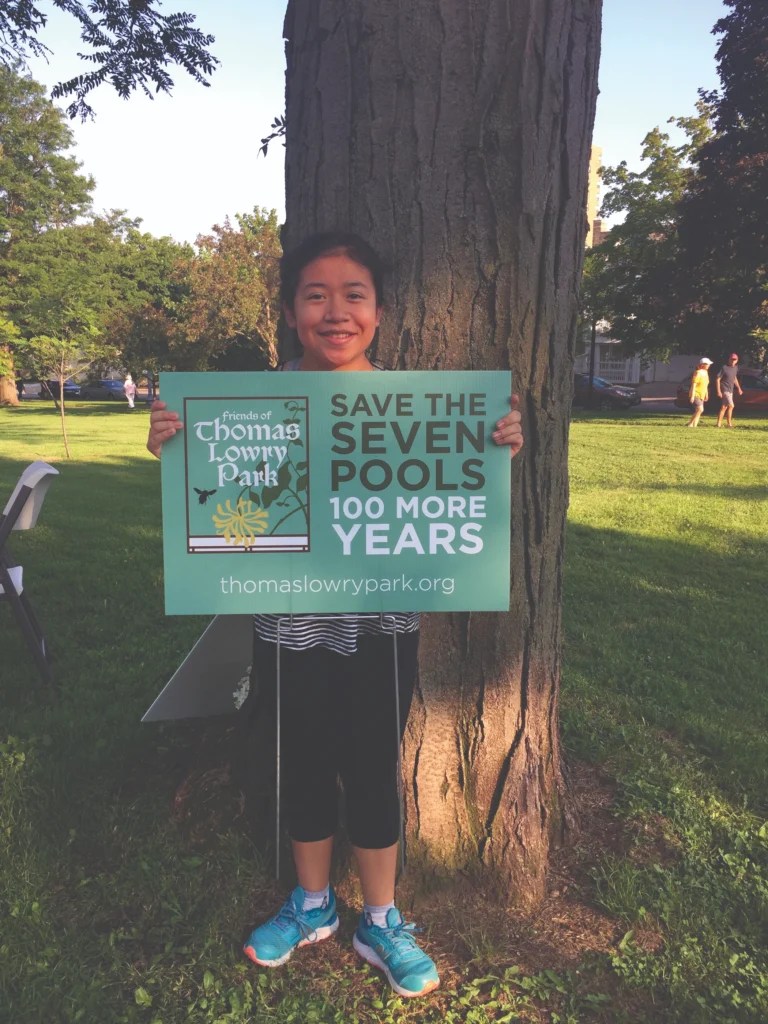
A Lasting Legacy
There are few places in our highly technological world that feel timeless. Thomas Lowry Park is one.
The activities today are the same ones that have always been enjoyed in the park. If you see a toddler splashing in the pools, kids playing tag, a couple holding hands on the bench, a volunteer planting tulip bulbs, or some teens sneaking alcohol on a summer evening, it is a shadow of those who did that same activity last year, last decade, last century.
With this restoration, donations and selfless volunteer hours, Thomas Lowry Park has the proven method to secure its ageless existence for the future residents of and visitors to our idyllic Lowry Hill.
Please join the FTLP volunteers on the second Saturday of each month from April to October! For more information on volunteering or donating to the park, please visit thomaslowrypark.org.

